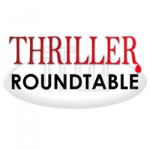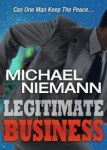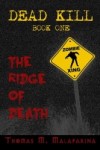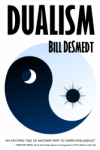 This week ITW Members Shiloh Walker, Thomas M. Malafarina, Bill DeSmedt, Michael Niemann, Lisa Von Biela, J. H. Bográn and Alan Field discuss setting limits. “At what point does a book require a map, a list of characters, a genealogical diagram? Can a plot get too intricate?”
This week ITW Members Shiloh Walker, Thomas M. Malafarina, Bill DeSmedt, Michael Niemann, Lisa Von Biela, J. H. Bográn and Alan Field discuss setting limits. “At what point does a book require a map, a list of characters, a genealogical diagram? Can a plot get too intricate?”
~~~~~
 Michael Niemann is a newcomer to crime fiction. His story “Africa Always Needs Guns” made it into the 2012 MWA Anthology. His thriller “Legitimate Business” was published in 2014 by Endeavour Press. In his previous life, he wrote a book on regionalism and numerous articles on global and African issues. He has traveled widely through Europe and southern Africa. A native German, he now lives in southern Oregon with his wife, who keeps him grounded, and his dog, who gets him up early.
Michael Niemann is a newcomer to crime fiction. His story “Africa Always Needs Guns” made it into the 2012 MWA Anthology. His thriller “Legitimate Business” was published in 2014 by Endeavour Press. In his previous life, he wrote a book on regionalism and numerous articles on global and African issues. He has traveled widely through Europe and southern Africa. A native German, he now lives in southern Oregon with his wife, who keeps him grounded, and his dog, who gets him up early.
Shiloh Walker is an award-winning writer…yes, really! She’s also a mom, a wife, a reader and she pretends to be an amateur photographer. She published her first book in 2003. Her newest series, Secrets and Shadows, launches in April 2014 with the release of Burn for Me, Break for Me & Long for Me.
 Lisa von Biela worked in Information Technology for 25 years, then left the field to attend the University of Minnesota Law School, graduating magna cum laude in 2009. She now practices law in Seattle, Washington. Lisa’s first short story appeared in The Edge in 2002. Her short works have appeared in various small press venues, including Gothic.net, Twilight Times, Dark Animus, AfterburnSF, and more. She is the author of the techno/medical thriller novels THE GENESIS CODE and THE JANUS LEGACY. Her noir/suspense novella, ASH AND BONE, is being released in May 2014, and her BigPharma thriller, BLOCKBUSTER, is scheduled for release in January 2015.
Lisa von Biela worked in Information Technology for 25 years, then left the field to attend the University of Minnesota Law School, graduating magna cum laude in 2009. She now practices law in Seattle, Washington. Lisa’s first short story appeared in The Edge in 2002. Her short works have appeared in various small press venues, including Gothic.net, Twilight Times, Dark Animus, AfterburnSF, and more. She is the author of the techno/medical thriller novels THE GENESIS CODE and THE JANUS LEGACY. Her noir/suspense novella, ASH AND BONE, is being released in May 2014, and her BigPharma thriller, BLOCKBUSTER, is scheduled for release in January 2015.
 Thomas M. Malafarina has published five horror novels, five collections of horror short stories and a book of single panel cartoons; all through Sunbury Press. Thomas’s works have appeared in dozens of short story anthologies and e-magazines. Thomas is known for the twists and surprises in his stories as well as his descriptive often-gory passages. He has been given him the reputation of being one who paints with words.
Thomas M. Malafarina has published five horror novels, five collections of horror short stories and a book of single panel cartoons; all through Sunbury Press. Thomas’s works have appeared in dozens of short story anthologies and e-magazines. Thomas is known for the twists and surprises in his stories as well as his descriptive often-gory passages. He has been given him the reputation of being one who paints with words.
Alan Field, new to the ITW, hopes to make a splash with his first urban thriller, The Chemist, that revolves around a weapon of mass destruction and the person who created it. Alan has written short stories starting from age 10, but this is the first work he wishes to publish. While practicing law for twenty years, Alan fathered four children. He is also an accomplished music composer and arranger who resides in New Jersey.
 Bill DeSmedt lives by his wits and his words, as — a Fortune 50 management consultant, an AI researcher/practitioner, an ontologist/knowledge engineer, and, in his copious spare time, a novelist. Bill draws on this checkered career history in penning his “Archon Sequence” technothrillers: cult-classic Singularity (2004), Dualism (appearing May 13th), and, next up, Triploidy. Bill writes from an aerie overlooking Milford PA, a town whose rich literary and philosophical tradition furnishes an inexhaustible source of inspiration.
Bill DeSmedt lives by his wits and his words, as — a Fortune 50 management consultant, an AI researcher/practitioner, an ontologist/knowledge engineer, and, in his copious spare time, a novelist. Bill draws on this checkered career history in penning his “Archon Sequence” technothrillers: cult-classic Singularity (2004), Dualism (appearing May 13th), and, next up, Triploidy. Bill writes from an aerie overlooking Milford PA, a town whose rich literary and philosophical tradition furnishes an inexhaustible source of inspiration.
 J. H. Bográn, born and raised in Honduras, is the son of a journalist. He ironically prefers to write fiction rather than fact. José’s genre of choice is thrillers, but he likes to throw in a twist of romance into the mix. His works include novels and short stories in both English and Spanish. His debut novel TREASURE HUNT, which The Celebrity Café hails as an intriguing novel that provides interesting insight of architecture and the life of a fictional thief, has also been selected as the Top Ten in Preditors & Editor’s Reader Poll. FIREFALL, his second novel, was released in 2013 by Rebel ePublishers. Coffee Time Romance calls it “a taut, compelling mystery with a complex, well-drawn main character.” He’s a member of The Crime Writers Association, the Short Fiction Writers Guild and the International Thriller Writers where he also serves as the Thriller Roundtable Coordinator and contributor editor their official e-zine The Big Thrill. You can find him on his website, Facebook, Amazon and Twitter @JHBogran
J. H. Bográn, born and raised in Honduras, is the son of a journalist. He ironically prefers to write fiction rather than fact. José’s genre of choice is thrillers, but he likes to throw in a twist of romance into the mix. His works include novels and short stories in both English and Spanish. His debut novel TREASURE HUNT, which The Celebrity Café hails as an intriguing novel that provides interesting insight of architecture and the life of a fictional thief, has also been selected as the Top Ten in Preditors & Editor’s Reader Poll. FIREFALL, his second novel, was released in 2013 by Rebel ePublishers. Coffee Time Romance calls it “a taut, compelling mystery with a complex, well-drawn main character.” He’s a member of The Crime Writers Association, the Short Fiction Writers Guild and the International Thriller Writers where he also serves as the Thriller Roundtable Coordinator and contributor editor their official e-zine The Big Thrill. You can find him on his website, Facebook, Amazon and Twitter @JHBogran
- Fiona Barton - April 11, 2025
- Bones in the Ashes - April 11, 2025
- A New Kind of Thriller Heroine - April 11, 2025


In my opinion, for the reader, yes, for the writer, no.
Readers are busy people–even the super-voracious ones. They can’t always sit down with a book and have a nice, long reading session. They have to read in bits and pieces. If a plot requires that sort of work to keep track of, I can see it being just too much for the reader to enjoy. I have to admit when I read DUNE a long time ago, the language drove me nuts. I hated having to break the flow to flip back and figure out what words meant so I could move on.
But for the writer, it’s a different story. I’m working on the plot for my next novel right now, and I absolutely use these tools to develop the plot/concept and other aspects. I am a continuity nut and I have to think through key plot concepts before I start drafting to make sure I don’t have any gaping plausibility holes. I draw up a list of my characters and some background on them that I can refer to as I draft to be sure they are consistent and that their motives and actions fit them throughout the book. And in novel-length thrillers, I find myself having to actually draw out a chart of the various plotlines so that events fit together in time, so that the pace is appropriate, so I alternate between POVs at appropriate points, and so forth. I need to visualize how all the elements are going to fit together. Then I outline and then I actually draft.
Indeed, yesterday afternoon, there I was, with 4 pieces of notepaper taped together, scratching out the various story arcs as well as the overarching plot, and, at the same time, making sure this work would be for my benefit and that I was not making it over-the-top complex, just clean and hopefully well-designed.
Good distinction, Lisa. I, too, create maps and lists and time charts to keep track of action and characters. It’s part of the prep work that leads to good story telling.
Wonderful answer, Lisa. In fact, you almost left me nothing more to add.
I do think adventure books and thrillers benefit with the interesting map at the beginning. One of my favorite writers, Clive Cusler, usually puts a map. I loved flipping the pages from the chapter to the map and back to really place me in the story. Then again, I may be a frustrated cartographer.
LOL, J. H., you should have seen me wrestle and fight that thing down into a manageable, followable, not too insanely complex outline the day after that posting. *Now* I can actually begin writing the thing!
I was tempted to include a map in my last thriller. It takes place in Darfur, Sudan. A place on the more obscure end of the “familiar-unknown” continuum for most readers. I decided not to do that. Here’s why.
The first job of any piece of fiction is to get readers to believe a story they know is made up. That can only be done by a well told story. If stories are so complex they requires maps or lists of characters, the storytellers haven’t done their job. Those devices become crutches, a projection of verisimilitude, signs that says “Hey, this really happened, here’s where it took place, those are the people who did it.”
At what point does a book require a map, a list of characters, a genealogical diagram? When the plot gets in the way of the storytelling.
Okay, there are exceptions. Translations, for example, may require maps simply because place names may sound or look very similar and a map highlighting places of actions can help. The same holds true for lists of characters with names that are difficult to pronounce for non-speakers of the language.
But I come back to Elmore Leonard’s ninth rule for writing: Don’t go into great detail describing places and things. For me, that includes maps, lists and charts. The story has to stand on its own.
I do find it worrisome when I start and new book and find a list of characters. My first reaction is “Oh, boy, this is a complicated one.”
Then, the because the story stand on its own, I seldom have to resort back to the character list.
This is a place where I have some experience. In my 2013 novel Fallen Stones genealogy plays a critical part in the story line. This was something I worried about all the while I was writing the story; how to get the info out there without putting everyone to sleep. There’s little I can imagine as boring as explaining a genealogical chart in a story.
As a result, I tried to do so in a way that allowed the reader to see the chart in small doses or segments from the point of view of the character while at the same time feeling what emotions were rising in the mind of said character. Since this character was possessed by a demon and not completely in control of her faculties, it made the emotional side of the genealogical research that much more important.
The bottom line is sometimes we have to get really boring stuff out there in order to explain the story. It’s our job as authors to find some way to do it without bringing the tempo of the story to a screeching halt.
Interesting. Now I’m curious to see that map.
In in a way, it made you push yourself.
Kudos.
Absolutely a plot can get too intricate. We’re readers as well and there have been books that I’ll just set aside because of info dumps. While that information might be necessary, there are ways of working it into the story without it being so dry and dull.
I think one way to do that is to have it as real in your (the writer’s) mind as possible before you begin to write. I’m not a plotter by nature and the ‘prep’ work that the more organized writers use don’t really come second nature, but when I have a plot that is going to be complicated, I do that prep work…I’ll draw maps, family trees, etc. I don’t put these in books, but when it’s clear in my mind, it’s more easy to pass on to the ready in smaller bites.
I think that unless maps, genealogy, etc actually play a huge part into the story, it might be a good idea to avoid them and just work that information into the story.
I think that is exactly the thing to do–draw the maps, family trees, etc. to get it so clear in your, the writer’s, mind that it will come out really organically in the story, rather than as some info dump. I could see that working yesterday as I began translating all that timeline and other detail into an outline. It really informed it, but a lot of that detail is not going to be presented in its original form to the reader. Having it clear in my own head will–let’s hope!–make for consistency, plausibility, etc.
Yep. Sometimes it just comes down to understanding the backstory…things the writer has to know, but not necessarily the reader needs to know.
This is not a hypothetical for me. At least as far as its technology aspects are concerned, not only could the plot for my latest technothriller DUALISM get way too complicated — it did! Here I was, trying to juggle artificial intelligence realized via quantum neural networks, an NSA-funded intranet with encryption bssed on quantum entanglement, and a hive mind spawned from the latter. …
Well, you get the point — something had to give! I took a long step back, threw away half the tech I had so laboriously and lovingly fabricated (Hemingway was right: you’ve got to kill your darlings), and moved ahead with a simpler, cleaner plotline.
That’s never easy, is it? I had a similar experience with an unpublished manuscript. It’s probably the key reason why it’s still unpublished.